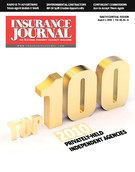A study by San Diego, Calif.-based DriveCam Inc., a global driver risk management company, shows that collisions and near collisions involving long haul trucks peak in July and remain high through the month of November. Collision rates are typically much lower during the first six months of the year.
The study is based on data provided by DriveCam’s Video Event Recorder, which is capable of identifying collisions, as well as near collisions that could have been avoided.
Using its database of more than 18 million driving events from 2 billion driving miles, DriveCam studied the distribution of collisions and near collisions identified in 2009 by month, day and year. It specifically compared commercial long haul trucking fleets to an aggregation of commercial fleets in various other industries, such as construction, distribution, energy, waste, telecommunications, local distribution and transit.
Collisions/Near Collisions by Month
Collisions and near collisions in the long haul trucking industry are very low from January to June – between 1 percent and 5 percent.
Beginning in July, the collision/near collision rate spikes – and actually peaks at 18 percent – remaining above 14 percent through November.
The collision/near collision rate in the long haul trucking industry is, on average, more than 5 percent higher than other industries from June to November.
By Day of Week
Collisions/near collisions peak on Tuesdays by 21 percent and Fridays by 20 percent in long haul trucking.
The long haul trucking collision/near collision rate is slightly lower than other industries on Wednesday and Thursday, as well as on Saturday and Sunday.
By Hour of Day
Collisions/near collision rate in long haul trucking remains below 4 percent from 11 p.m. until 9 a.m.
Beginning at 9 a.m., the collision rate in long haul trucking begins to climb with a small dip between 1 p.m. and 2 p.m. before increasingly sharply.
The long haul trucking collision/near collision rate peaks between 3 p.m. and 4 p.m. at 9 percent, takes a sharp nosedive and then rises to 6.5 percent between 8 p.m. and 9 p.m. before starting a decline below 4 percent.
In an earlier long haul trucking study, DriveCam found that the driving practices of following too close and not looking far ahead are more likely to cause risky driving events than distractions such as use of a hand held cell phone in the long haul trucking industry.
Details and graphs can be found at www.drivecam.com/fleet/insights.aspx.
Was this article valuable?
Here are more articles you may enjoy.


 Big ‘I’ Report: Independent Agency Channel Placed 62% of Premiums in 2023
Big ‘I’ Report: Independent Agency Channel Placed 62% of Premiums in 2023  Ford Recalls 668,000 2014 F-150 Pickup Trucks Over Transmission Issue
Ford Recalls 668,000 2014 F-150 Pickup Trucks Over Transmission Issue  US Judge Skeptical of Biden Overtime Pay Rule
US Judge Skeptical of Biden Overtime Pay Rule  Coverage Needed: Hundreds of Thousands in SE Now in Flood Zones With New Maps
Coverage Needed: Hundreds of Thousands in SE Now in Flood Zones With New Maps 


